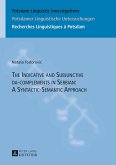
Gebundenes Buch
30. Juni 2015
Peter Lang
265234

eBook, PDF
20. März 2020
Nova Science Publishers Inc
Ähnliche Artikel

Gebundenes Buch
Proceedings of Formal Description of Slavic Languages 7.5
1. Juni 2010
Peter Lang
58680

Broschiertes Buch
The Fifth Conference, Leipzig 2003
18. März 2008
Peter Lang
55160

Broschiertes Buch
Proceedings of FDSL 7, Leipzig 2007
8. September 2009
Peter Lang
57788


Gebundenes Buch
Toward a Lexicon of Common Figurative Units
29. Juni 2012
Peter Lang
310579

Gebundenes Buch
2. November 2015
Peter Lang
266587

Gebundenes Buch
Syntax - Information Structure - Discourse Organization
10. Juli 2016
Peter Lang
266127

Broschiertes Buch
The case of Romanian Learner English
31. Juli 2014
Peter Lang
431410


Gebundenes Buch
Proceedings of FDSL 9, Göttingen 2011
17. Januar 2013
Peter Lang
262353
Ähnlichkeitssuche: Fact®Finder von OMIKRON
